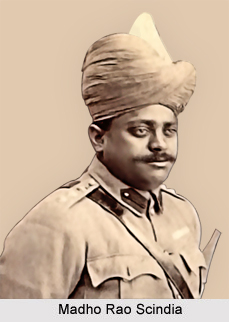 Madho Rao Scindia was one of the most prominent and the 5th Maharaja Scindia of Gwalior. He was born on 20th October 1876. Madho Rao acceded to the royal throne in the year 1886 and ruled to till the year 1925, when he died. The British administration recognized him as a noted and progressive ruler of one of the most important princely states of India. Madho Rao Scindia of Gwalior married twice but had children only from his second wife in the year 1913. The royal couple had one daughter and one son; and King George V and Queen Mary were the sponsors of the children. Maharajdhiraja Maharaja Sir George Jivaji Rao Scindia, the only son of Madho Rao Scindia, succeeded him and became the 6th Maharaja Scindia of Gwalior. The daughter of the Maharaja was married but died in the year 1934. The Maharaja of Gwalior, Madho Rao Scindia, was also well known as the rejected suitor of Princess Indira of Baroda (mother of Gayatri Devi), who broke her engagement through a letter.
Madho Rao Scindia was one of the most prominent and the 5th Maharaja Scindia of Gwalior. He was born on 20th October 1876. Madho Rao acceded to the royal throne in the year 1886 and ruled to till the year 1925, when he died. The British administration recognized him as a noted and progressive ruler of one of the most important princely states of India. Madho Rao Scindia of Gwalior married twice but had children only from his second wife in the year 1913. The royal couple had one daughter and one son; and King George V and Queen Mary were the sponsors of the children. Maharajdhiraja Maharaja Sir George Jivaji Rao Scindia, the only son of Madho Rao Scindia, succeeded him and became the 6th Maharaja Scindia of Gwalior. The daughter of the Maharaja was married but died in the year 1934. The Maharaja of Gwalior, Madho Rao Scindia, was also well known as the rejected suitor of Princess Indira of Baroda (mother of Gayatri Devi), who broke her engagement through a letter.
Titles of Madho Rao Scindia
Maharaja Madho Rao Scindia of Gwalior held several titles through out his reign. These are mentioned below-
* Yuvaraja Maharaj Shrimant Madho Rao Scindia Bahadur (1876- 1886)
* His Highness Ali Jah, Umdat ul-Umara, Hisam us-Sultanat, Mukhtar ul-Mulk, Azim ul-Iqtidar, Rafi-us-Shan, Wala Shikoh, Muhtasham-i-Dauran, Maharajadhiraj Maharaja Shrimant Madho Rao Scindia Bahadur, Shrinath, Mansur-i-Zaman, Fidvi-i-Hazrat-i-Malika-i-Mua`zzama-i-Rafi-ud-Darja-i-Inglistan, Maharaja Scindia of Gwalior (1886- 1895)
* His Highness Ali Jah, Umdat ul-Umara, Hisam us-Sultanat, Mukhtar ul-Mulk, Azim ul-Iqtidar, Rafi-us-Shan, Wala Shikoh, Muhtasham-i-Dauran, Maharajadhiraj Maharaja Shrimant Sir Madho Rao Scindia Bahadur, Shrinath, Mansur-i-Zaman, Fidvi-i-Hazrat-i-Malika-i-Mua`zzama-i-Rafi-ud-Darja-i-Inglistan, Maharaja Scindia of Gwalior, GCSI (1895- 1898)
* Colonel His Highness Ali Jah, Umdat ul-Umara, Hisam us-Sultanat, Mukhtar ul-Mulk, Azim ul-Iqtidar, Rafi-us-Shan, Wala Shikoh, Muhtasham-i-Dauran, Maharajadhiraj Maharaja Shrimant Sir Madho Rao Scindia Bahadur, Shrinath, Mansur-i-Zaman, Fidvi-i-Hazrat-i-Malika-i-Mua`zzama-i-Rafi-ud-Darja-i-Inglistan, Maharaja Scindia of Gwalior, GCSI (1898- 1900)
* Colonel His Highness Ali Jah, Umdat ul-Umara, Hisam us-Sultanat, Mukhtar ul-Mulk, Azim ul-Iqtidar, Rafi-us-Shan, Wala Shikoh, Muhtasham-i-Dauran, Maharajadhiraj Maharaja Shrimant Sir Madho Rao Scindia Bahadur, Shrinath, Mansur-i-Zaman, Fidvi-i-Hazrat-i-Malika-i-Mua`zzama-i-Rafi-ud-Darja-i-Inglistan, Maharaja
Scindia of Gwalior, GCSI, KIH (1900- 1902)
* Colonel His Highness Ali Jah, Umdat ul-Umara, Hisam us-Sultanat, Mukhtar ul-Mulk, Azim ul-Iqtidar, Rafi-us-Shan, Wala Shikoh, Muhtasham-i-Dauran, Maharajadhiraj Maharaja Shrimant Sir Madho Rao Scindia Bahadur, Shrinath, Mansur-i-Zaman, Fidvi-i-Hazrat-i-Malika-i-Mua`zzama-i-Rafi-ud-Darja-i-Inglistan, Maharaja Scindia of Gwalior, GCSI, GCVO, KIH (1902- 1910)
* Major-General His Highness Ali Jah, Umdat ul-Umara, Hisam us-Sultanat, Mukhtar ul-Mulk, Azim ul-Iqtidar, Rafi-us-Shan, Wala Shikoh, Muhtasham-i-Dauran, Maharajadhiraj Maharaja Shrimant Sir Madho Rao Scindia Bahadur, Shrinath, Mansur-i-Zaman, Fidvi-i-Hazrat-i-Malika-i-Mua`zzama-i-Rafi-ud-Darja-i-Inglistan, Maharaja Scindia of Gwalior, GCSI, GCVO, KIH (1910- 1917)
* Major-General His Highness Ali Jah, Umdat ul-Umara, Hisam us-Sultanat, Mukhtar ul-Mulk, Azim ul-Iqtidar, Rafi-us-Shan, Wala Shikoh, Muhtasham-i-Dauran, Maharajadhiraj Maharaja Shrimant Sir Madho Rao Scindia Bahadur, Shrinath, Mansur-i-Zaman, Fidvi-i-Hazrat-i-Malika-i-Mua`zzama-i-Rafi-ud-Darja-i-Inglistan, Maharaja Scindia of Gwalior, GCSI, GCVO, GBE, KIH (1917- 1918)
* Lieutenant-General His Highness Ali Jah, Umdat ul-Umara, Hisam us-Sultanat, Mukhtar ul-Mulk, Azim ul-Iqtidar, Rafi-us-Shan, Wala Shikoh, Muhtasham-i-Dauran, Maharajadhiraj Maharaja Shrimant Sir Madho Rao Scindia Bahadur, Shrinath, Mansur-i-Zaman, Fidvi-i-Hazrat-i-Malika-i-Mua`zzama-i-Rafi-ud-Darja-i-Inglistan, Maharaja Scindia of Gwalior, GCSI, GCVO, GBE, KIH (1918- 1925)
Honours of Madho Rao Scindia
* Knight Grand Commander of the Order of the Star of India- GCSI (1895)
* Kaiser-i-Hind, 1st Class- KIH (1900)
* China War Medal (1901)
* Knight Grand Cross of the Royal Victorian Order- GCVO (1902)
* King Edward VII Coronation Medal (1902)
* Grand Cross of the Order of Philip the Magnanimous of Hesse (1903)
* Delhi Durbar Gold Medal (1903)
* King George V Coronation Medal (1911)
* Bailiff Grand Cross of the Order of St John- GCStJ (1911)
* Delhi Durbar Gold Medal (1911)
* Knight Grand Cross of the Order of the British Empire- GBE (1917)



















